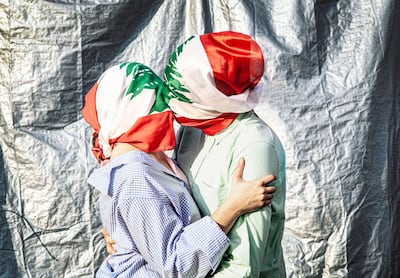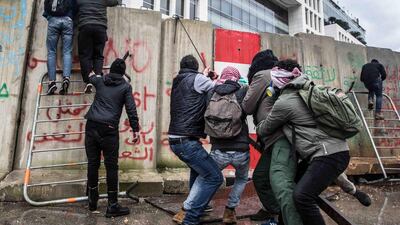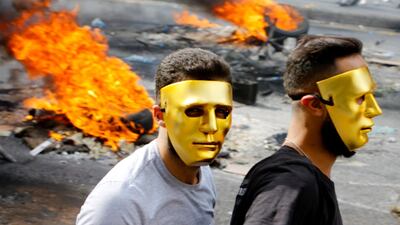Long power cuts. A banking system in collapse. People on the streets in protest. How can you picture the full chaos of Lebanon today?
The Middle East Institute (MEI), a think tank in Washington, DC that runs an art programme and exhibition space, is hosting a virtual exhibition of Lebanese photographers designed to do just that: give an image of the present-day Lebanon that understands its historical context.
Lebanon Then and Now: Photography from 2006 to 2020 links the Civil War to the current crisis, drawing from work put together by a consortium of Lebanese organisations and the Paris-based Institut du Monde Arabe (IMA).
“The show was meant to be a selection of works from a show that honoured Lebanon at the Institut du Monde Arabe last fall,” explains Lyne Sneige, the director of the Art and Culture programme at MEI. “But then the October protests kicked in and we at MEI decided we can’t just present a show on Lebanon when things have changed so drastically.”
The Civil War ended in 1991, and since then there hasn't been a proper process for healing of the society, or for any serious economic social regeneration plans for the country
The organisation switched tack and partnered with the Beirut Centre of Photography and the nonprofit organisation Apeal to show images of the present moment. Curated by Chantale Fahmi, the exhibition sets side-by-side works from IMA’s Lebanon: Between Reality and Fiction, which looked at the aftermath of the Lebanese Civil War, and newer – and more raw – photographs from the exhibition Revolt, which appeared last fall in an outdoor site close to the protests in Beirut, documenting the recent unrest, the coronavirus lockdown, and the current economic crisis.
Sneige explains that the crisis is a legacy of the Civil War.
“The Civil War ended in 1991, and since then there hasn’t been a proper process for healing of the society, or for any serious economic social regeneration plans for the country,” says Sneige, who grew up in Beirut and spent most of her working life there. “After years of economic and and political mismanagement, you get to a point where the system has imploded.”
Many of the images in the show could just as easily be circulating on Twitter or published in today's newspapers, and succinctly communicate the scale of the response among the Lebanese people to the political crisis.
In a photograph by Hussein Beydoun of a women’s march, a suavely dressed woman in black sunglasses presses her cheek against that of a hijabi woman in no make-up – a keen representation of how the protests have united Lebanon's numerous factions.
A nearby picture by Blanche Eid, The Next Day, taken on October 18, 2019, captures an old woman mid-celebration, her arms outstretched and her face full of joy as a Lebanese flag waves just beyond her shoulder. Painfully, the images also track the violence met by the protests, and their disillusionment, as last October's optimism has run aground on the banking crisis and Covid-19.
A picture that Beydoun captured in April shows a man outside a burnt-out bank in Tripoli selling surgical masks, fanned out in a black-gloved hand.
Omar Sfeir's iconic, if slightly mannered, image of two people kissing through the Lebanese flag (The Lovers in Times of Revolution, taken on October 21, 2019) has gained even more resonance since the coronavirus struck, as the flag wrapped around their faces now conjures Covid-19 masks.
Likewise, other works deliberately juxtapose a sense of present and past, such as a photograph taken by Lamia Maria Abillama that shows three older women at home in fatigues, and a young daughter, her round face the picture of innocence and youth, standing in front of them in a gauzy blue dress (Clashing Realities (1–2), 2006–ongoing). The era of combat feels at once sequestered in the past, and very much alive in memory.
The historical context is key to the show, says Sneige, because of Lebanon’s difficulties in finding a neutral representation of post-Civil War events. With its traditionally strong cultural sector, artists have stepped into this breach, from contemporary artists' investigations into the ambiguity of photographs as a mode of documentation, to the way that current photographers are creating a living archive of history.
“This is history that doesn’t exist in history books,” she says of the photographers’ treatment of the Civil War and its aftermath. “History books stop in 1943, when Lebanon acquires its independence – because no one can agree how to write the history of the Civil War. That kind of cultural memory of the country, which is so, so important, is actually carried until now by the creative sector. It is carried by the filmmakers, the photographers, the artists. Their work is documenting this period that does not exist anywhere except for in the minds of the people who lived it.”
Many of the photographers in Revolt were born in the 1980s or 90s, meaning they did not experience the Civil War first-hand. But if this younger generation has looked to move on from the “burden” – as Sneige puts it – of representing the Civil War, the new state of unrest in Lebanon unwillingly provides a pictorial continuity with the images of the country that proliferated in the 1980s. Ironically, in this show the older images provide a sense of stasis: their mode of reflection on the past, even a past pockmarked by violence, runs counter to the photographs of smoke clouds, lines of servicemen, and the generalised fears of contagion signalled by surgical masks. In the uncanny, un-sited space of the virtual exhibition, this is a show that hangs in the air: in Lebanon, in Washington, DC, everywhere, we are all waiting for the dust to settle.
The virtual exhibition Lebanon Then and Now: Photography from 2006 to 2020 runs from July 13, 2020 to September 25, 2020
Inside%20Out%202
%3Cp%3E%3Cstrong%3EDirector%3A%C2%A0%3C%2Fstrong%3EKelsey%20Mann%3C%2Fp%3E%0A%3Cp%3E%3Cstrong%3EStarring%3A%3C%2Fstrong%3E%C2%A0Amy%20Poehler%2C%20Maya%20Hawke%2C%20Ayo%20Edebiri%3C%2Fp%3E%0A%3Cp%3E%3Cstrong%3ERating%3A%20%3C%2Fstrong%3E4.5%2F5%3C%2Fp%3E%0A
Five personal finance podcasts from The National
To help you get started, tune into these Pocketful of Dirham episodes
·
Balance is essential to happiness, health and wealth
·
What is a portfolio stress test?
·
What are NFTs and why are auction houses interested?
·
How gamers are getting rich by earning cryptocurrencies
·
Should you buy or rent a home in the UAE?
The specs
Engine: 4.0-litre V8 twin-turbocharged and three electric motors
Power: Combined output 920hp
Torque: 730Nm at 4,000-7,000rpm
Transmission: 8-speed dual-clutch automatic
Fuel consumption: 11.2L/100km
On sale: Now, deliveries expected later in 2025
Price: expected to start at Dh1,432,000
Frankenstein in Baghdad
Ahmed Saadawi
Penguin Press
THE SPECS – Honda CR-V Touring AWD
Engine: 2.4-litre 4-cylinder
Power: 184hp at 6,400rpm
Torque: 244Nm at 3,900rpm
Transmission: Continuously Variable Transmission (CVT)
0-100kmh in 9.4 seconds
Top speed: 202kmh
Fuel consumption: 6.8L/100km
Price: From Dh122,900
Warlight,
Michael Ondaatje, Knopf
The specs
- Engine: 3.9-litre twin-turbo V8
- Power: 640hp
- Torque: 760nm
- On sale: 2026
- Price: Not announced yet
COMPANY%20PROFILE
%3Cp%3E%3Cstrong%3EName%3A%20%3C%2Fstrong%3EEjari%3Cbr%3E%3Cstrong%3EBased%3A%20%3C%2Fstrong%3ERiyadh%2C%20Saudi%20Arabia%3Cbr%3E%3Cstrong%3EFounders%3A%20%3C%2Fstrong%3EYazeed%20Al%20Shamsi%2C%20Fahad%20Albedah%2C%20Mohammed%20Alkhelewy%20and%20Khalid%20Almunif%3Cbr%3E%3Cstrong%3ESector%3A%20%3C%2Fstrong%3EPropTech%3Cbr%3E%3Cstrong%3ETotal%20funding%3A%20%3C%2Fstrong%3E%241%20million%3Cbr%3E%3Cstrong%3EInvestors%3A%20%3C%2Fstrong%3ESanabil%20500%20Mena%2C%20Hambro%20Perks'%20Oryx%20Fund%20and%20angel%20investors%3Cbr%3E%3Cstrong%3ENumber%20of%20employees%3A%20%3C%2Fstrong%3E8%3C%2Fp%3E%0A
hall of shame
SUNDERLAND 2002-03
No one has ended a Premier League season quite like Sunderland. They lost each of their final 15 games, taking no points after January. They ended up with 19 in total, sacking managers Peter Reid and Howard Wilkinson and losing 3-1 to Charlton when they scored three own goals in eight minutes.
SUNDERLAND 2005-06
Until Derby came along, Sunderland’s total of 15 points was the Premier League’s record low. They made it until May and their final home game before winning at the Stadium of Light while they lost a joint record 29 of their 38 league games.
HUDDERSFIELD 2018-19
Joined Derby as the only team to be relegated in March. No striker scored until January, while only two players got more assists than goalkeeper Jonas Lossl. The mid-season appointment Jan Siewert was to end his time as Huddersfield manager with a 5.3 per cent win rate.
ASTON VILLA 2015-16
Perhaps the most inexplicably bad season, considering they signed Idrissa Gueye and Adama Traore and still only got 17 points. Villa won their first league game, but none of the next 19. They ended an abominable campaign by taking one point from the last 39 available.
FULHAM 2018-19
Terrible in different ways. Fulham’s total of 26 points is not among the lowest ever but they contrived to get relegated after spending over £100 million (Dh457m) in the transfer market. Much of it went on defenders but they only kept two clean sheets in their first 33 games.
LA LIGA: Sporting Gijon, 13 points in 1997-98.
BUNDESLIGA: Tasmania Berlin, 10 points in 1965-66
Points about the fast fashion industry Celine Hajjar wants everyone to know
- Fast fashion is responsible for up to 10 per cent of global carbon emissions
- Fast fashion is responsible for 24 per cent of the world's insecticides
- Synthetic fibres that make up the average garment can take hundreds of years to biodegrade
- Fast fashion labour workers make 80 per cent less than the required salary to live
- 27 million fast fashion workers worldwide suffer from work-related illnesses and diseases
- Hundreds of thousands of fast fashion labourers work without rights or protection and 80 per cent of them are women
What the law says
Micro-retirement is not a recognised concept or employment status under Federal Decree Law No. 33 of 2021 on the Regulation of Labour Relations (as amended) (UAE Labour Law). As such, it reflects a voluntary work-life balance practice, rather than a recognised legal employment category, according to Dilini Loku, senior associate for law firm Gateley Middle East.
“Some companies may offer formal sabbatical policies or career break programmes; however, beyond such arrangements, there is no automatic right or statutory entitlement to extended breaks,” she explains.
“Any leave taken beyond statutory entitlements, such as annual leave, is typically regarded as unpaid leave in accordance with Article 33 of the UAE Labour Law. While employees may legally take unpaid leave, such requests are subject to the employer’s discretion and require approval.”
If an employee resigns to pursue micro-retirement, the employment contract is terminated, and the employer is under no legal obligation to rehire the employee in the future unless specific contractual agreements are in place (such as return-to-work arrangements), which are generally uncommon, Ms Loku adds.
Cricket World Cup League Two
Oman, UAE, Namibia
Al Amerat, Muscat
Results
Oman beat UAE by five wickets
UAE beat Namibia by eight runs
Fixtures
Wednesday January 8 –Oman v Namibia
Thursday January 9 – Oman v UAE
Saturday January 11 – UAE v Namibia
Sunday January 12 – Oman v Namibia
more from Janine di Giovanni
Living in...
This article is part of a guide on where to live in the UAE. Our reporters will profile some of the country’s most desirable districts, provide an estimate of rental prices and introduce you to some of the residents who call each area home.
Company%20profile
%3Cp%3E%3Cstrong%3ECompany%20name%3A%3C%2Fstrong%3E%20Fasset%0D%3Cbr%3E%3Cstrong%3EStarted%3A%20%3C%2Fstrong%3E2019%0D%3Cbr%3E%3Cstrong%3EFounders%3A%3C%2Fstrong%3E%20Mohammad%20Raafi%20Hossain%2C%20Daniel%20Ahmed%0D%3Cbr%3E%3Cstrong%3EBased%3A%3C%2Fstrong%3E%20Dubai%0D%3Cbr%3E%3Cstrong%3ESector%3A%20%3C%2Fstrong%3EFinTech%0D%3Cbr%3E%3Cstrong%3EInitial%20investment%3A%3C%2Fstrong%3E%20%242.45%20million%0D%3Cbr%3E%3Cstrong%3ECurrent%20number%20of%20staff%3A%3C%2Fstrong%3E%2086%0D%3Cbr%3E%3Cstrong%3EInvestment%20stage%3A%3C%2Fstrong%3E%20Pre-series%20B%0D%3Cbr%3E%3Cstrong%3EInvestors%3A%3C%2Fstrong%3E%20Investcorp%2C%20Liberty%20City%20Ventures%2C%20Fatima%20Gobi%20Ventures%2C%20Primal%20Capital%2C%20Wealthwell%20Ventures%2C%20FHS%20Capital%2C%20VN2%20Capital%2C%20local%20family%20offices%3C%2Fp%3E%0A
Engine: 5.6-litre V8
Transmission: seven-speed automatic
Power: 400hp
Torque: 560Nm
Price: Dh234,000 - Dh329,000
On sale: now
WHAT IS GRAPHENE?
It was discovered in 2004, when Russian-born Manchester scientists Andrei Geim and Kostya Novoselov were experimenting with sticky tape and graphite, the material used as lead in pencils.
Placing the tape on the graphite and peeling it, they managed to rip off thin flakes of carbon. In the beginning they got flakes consisting of many layers of graphene. But when they repeated the process many times, the flakes got thinner.
By separating the graphite fragments repeatedly, they managed to create flakes that were just one atom thick. Their experiment led to graphene being isolated for the very first time.
In 2010, Geim and Novoselov were awarded the Nobel Prize for Physics.
What is blockchain?
Blockchain is a form of distributed ledger technology, a digital system in which data is recorded across multiple places at the same time. Unlike traditional databases, DLTs have no central administrator or centralised data storage. They are transparent because the data is visible and, because they are automatically replicated and impossible to be tampered with, they are secure.
The main difference between blockchain and other forms of DLT is the way data is stored as ‘blocks’ – new transactions are added to the existing ‘chain’ of past transactions, hence the name ‘blockchain’. It is impossible to delete or modify information on the chain due to the replication of blocks across various locations.
Blockchain is mostly associated with cryptocurrency Bitcoin. Due to the inability to tamper with transactions, advocates say this makes the currency more secure and safer than traditional systems. It is maintained by a network of people referred to as ‘miners’, who receive rewards for solving complex mathematical equations that enable transactions to go through.
However, one of the major problems that has come to light has been the presence of illicit material buried in the Bitcoin blockchain, linking it to the dark web.
Other blockchain platforms can offer things like smart contracts, which are automatically implemented when specific conditions from all interested parties are reached, cutting the time involved and the risk of mistakes. Another use could be storing medical records, as patients can be confident their information cannot be changed. The technology can also be used in supply chains, voting and has the potential to used for storing property records.
PREMIER LEAGUE RESULTS
Bournemouth 1 Manchester City 2
Watford 0 Brighton and Hove Albion 0
Newcastle United 3 West Ham United 0
Huddersfield Town 0 Southampton 0
Crystal Palace 0 Swansea City 2
Manchester United 2 Leicester City 0
West Bromwich Albion 1 Stoke City 1
Chelsea 2 Everton 0
Tottenham Hotspur 1 Burnley 1
Liverpool 4 Arsenal 0
Babumoshai Bandookbaaz
Director: Kushan Nandy
Starring: Nawazuddin Siddiqui, Bidita Bag, Jatin Goswami
Three stars
UAE currency: the story behind the money in your pockets
Global state-owned investor ranking by size
|
1.
|
United States
|
|
2.
|
China
|
|
3.
|
UAE
|
|
4.
|
Japan
|
|
5
|
Norway
|
|
6.
|
Canada
|
|
7.
|
Singapore
|
|
8.
|
Australia
|
|
9.
|
Saudi Arabia
|
|
10.
|
South Korea
|










